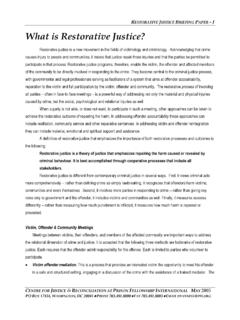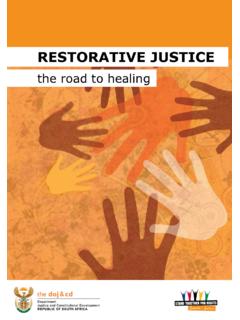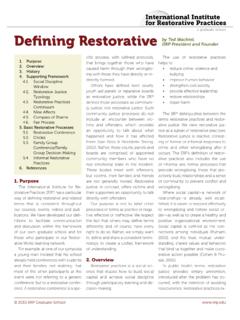Transcription of The Little Book of Restorative Justice by Howard Zehr
1 The Little book of Restorative Justice by Howard Zehr Notes by Neekaan Oshidary Short Summary Chapter 1: An Overview Short Summary Chapter 2: Restorative Principles Short Summary Chapter 3: Restorative Practices Short Summary Chapter 4: Where From Here Short Summary Detailed Summary Chapter 1: An Overview Detailed Summary Chapter 2: Restorative Principles Detailed Summary Chapter 3: Restorative Practices Detailed Summary Chapter 4: Where From Here Detailed Summary Short Summary Chapter 1: An Overview Short Summary Restorative Justice is a movement to address the needs and roles of victims of crime, offenders, and communities, rather than the legalistic system that holds offenders purely in relation to violation of the state and law.
2 Victim needs include a sense of increased involvement and empowerment with the criminal Justice process, including learning the facts contributing the crime and allowing healing through the telling of their story. Offender needs center around having the offender empathize with the victim and take responsibility for their actions. The community is involved as a secondary victim and is encouraged to have their voices heard, while also contributing to how a safer, healthier community can be achieved. Restorative Justice may sometimes lead to beneficial byproducts, such as reconciliation and forgiveness as well as decreased recidivism and repeat offenses, but these are not necessarily required or central to the process.
3 The reason for RJ is that it is the best thing to do to heal and address the needs of stakeholders involved in a crime. Also, in contrast to misconceptions, RJ is not meant as a substitute for the legal system or prisons necessarily (it can often work well in parallel with these). Importantly, RJ does not imply a return to past experiences of a status quo which may in fact be troubled, but rather a transformation to our better selves and communities which are always available to us as a potential. Chapter 2: Restorative Principles Short Summary Restorative Justice can be defined as an approach toward achieving Justice that, to the best extent possible, involves all the stakeholders involved in a crime to address the harms, needs, and obligations arising from the crime by putting right and enabling healing to the greatest extent possible.
4 The 3 pillars of RJ are harms, needs, and obligations. At its core, RJ is about putting right wrongs and harms grounded in respect for all , which stems from an acknowledgment of interconnectedness but also diversity this is done by focusing on harms and needs, addressing obligations, involving all stakeholders, and by using collaborative, inclusive processes. RJ is not a specific program, but through relying on the guiding questions and signposts of RJ, we shift the question from What does the offender deserve? to What are the harms, needs, and obligations of a crime? Who needs to be involved? How do we address these and the underlying causes?
5 Chapter 3: Restorative Practices Short Summary Restorative Justice has a range of applications and forms. Core to most approaches is a facilitated encounter. Popular forms include victim offender conferences (VOC), family group conferences (FGC), and circles, but more often these days aspects of all these are being blended. FGCs have worked especially well in New Zealand as an alternate to the judicial system for juveniles, as this came out of the family oriented approach to juvenile corrections in the native traditions there. Circles, where all stakeholders form a circle and take turns speaking through a talking piece with the aid of facilitators (aka circle keepers ), have had the widest appeal across the globe, and Zehr refers to it as the closest thing to a universal' model of addressing harm and conflict.
6 Goals for Restorative Justice vary from being an alternative to the judicial process, to promoting healing and therapeutic processes, to transitioning from prison into society. Based on how closely the RJ goals are being addressed, practices can fall along a continuum of fully Restorative to mostly, partial, potentially, and pseudo or non Restorative . Chapter 4: Where From Here Short Summary Retributive Justice of the Western legal system and Restorative Justice are not polar opposites. In fact, they both involve the balancing of scales in response to a wrongdoing. They simply differ on the response to balance the scales. Retributive Justice believes in pain and punishment balancing the scales, while Restorative Justice focuses on acknowledging and addressing harms, needs, obligations, and getting at causes.
7 Zehr imagines a world where our Justice system is as Restorative as possible. Zehr concludes that Restorative Justice , as others have come to tell him, can be a way of life, a philosophy grounded in 3 R values: respect, responsibility, and relationship. He concludes by saying that Restorative Justice is like a river with many sources though it began in the 70s in its modern form in North America, it has deeper sources in traditional societies and many tributaries are and will be its source. Ultimately, it is a reminder that all of us are indeed embedded in a web of relationships (82). Detailed Summary Chapter 1: An Overview Detailed Summary Restorative Justice is an alternate form of criminal Justice that focuses on addressing the needs of victims and community and the obligations of the offender.
8 This is in contrast to offenses done against a state or the law. Restorative Justice began (in its modern form) in the 1970s to address burglary and property crimes, but since has expanded to very serious offenses like rape and murder. Restorative Justice , like other movements, runs the risk of leading to too many offshoots that don't stay true to the foundational principles and risk diluting or co opting the movement. Hence this book . Restorative Justice has expanded to school and university settings. The movement also needs to re examine the effects of racial bias (vis a vis The New Jim Crow by Michelle Alexander). Some have called into question the over simplified labels of victim and offender , especially in contexts where responsibility is diffuse ( school setting), and some have also preferred Restorative practices over Restorative Justice .
9 It's important to stress what Restorative Justice is not.. Restorative Justice : is not primarily about forgiveness and reconciliation.. Though this may happen as a byproduct, no one should be pressured to forgive. does not imply a return to past circumstances.. Some things can't be restored ( murder of a child), nor can some offenders with terrible history of abuse be restored rather things must be transformed , it is not a movement to the status quo, but rather transformation to bring out the goodness that has always been available but missed. Beautiful quote by attorney Fania Davis (in email to Zehr): It's not about returning to the . pre conflict status quo but about returning to one's best self that's always there.
10 When well facilitated, RJ processes create the possibility for transformation of people, relationships, and communities. This is often a radical departure from the pre conflict status quo. So what are we restoring? For me it's about returning to the part of us that really wants to be connected to one another in a good way. Returning to the goodness inherent in all of us. One might say, returning to the divinity present in all of us. Or as indigenous elders put it, returning to that part of us which is related to all things. (14, 15) is not mediation .. Sometimes parties don't want to meet, so it's not necessarily about an encounter. Also, mediation assumes two parties are on equal moral footing, which is not the case in Restorative Justice .







